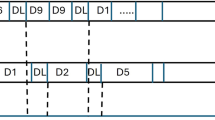Abstract
One of the key issues in cellular mobile communication is to find the current location of mobile terminal (MT) to deliver the services, which is called location management (LM). Much research has been done on dynamic LM that reduced the LM cost up to a large extent. In movement based dynamic LM scheme, the location area is defined in the form of ring of cells for individual user. Whenever an MT visits a cell outside of its current location area (LA), it triggers location update (LU). For this purpose, network must inform the mobile terminal about ID of all the cells present in its current location area. In this paper, a simple way of cell-ID assignment is proposed under which, network sends only the ID of center cell of LA ring to MT and then MT can compute IDs of all other cells in its location area. This saves a significant amount of wireless bandwidth by minimizing the signaling traffic at VLR level and thus reduces the mobility management overhead.












Similar content being viewed by others
References
Akyildiz, I. F., & Ho, J. S. M. (1996). On location management for personal communications networks. IEEE Communications Magazine, 138–145. doi:10.1109/35.536562.
Akyildiz, I. F., Ho, J. S. M., & Lin, Y.-B. (1996). Movement-based location update and selective paging for PCS networks. IEEE/ACM Transactions on Networking, 4(4), 629–638.
Beheshti Babak, D. (2007). Review of location management in cellular networks. In Systems, applications and technology conference (pp. 1–6).
Biswash, S. K., & Chiranjeev, K. (2011). An efficient metric-based (EM-B) location management scheme for wireless cellular networks. Journal of Network and Computer Applications, 01–16. doi:10.1016/j.jnca.2011.07.009.
Brusic, I., Hassler, V., & Lugmayr, W. (2001). Mobile agents in the mobile telephone network management. Telecommunications Systems, 18(1–3), 243–254.
Chen, I.-R., Gu, B., & Cheng, S.-T. (2006). On integrated location and service management for minimizing network cost in personal communication systems. IEEE Transaction on Mobile Computing, 179–192. doi:10.1109/TMC.2006.23.
Fan, G., & Zhang, J. (2004). A multi-layer location management scheme that bridges the best static scheme and the best dynamic scheme. In IEEE international conference on mobile data management (pp. 125–132).
Goel, A., Gupta, N., & Kumar, P. (2009). A speed based adaptive algorithm for reducing paging cost in cellular networks. In 2nd IEEE international conference on computer science and information technology (pp. 22–25).
Lee, C. Y., Kim, S. J., & Park, T. (2000). A design of multi-layered location registration areas in microcellular systems. Telecommunications Systems, 14(1–4), 107–120.
Li, L., Pan, Y., & Li, J. (2003). An improved movement-based location management scheme for PCS network. In IEEE vehicular technology conference (pp. 757–760).
Li, J., Pan, Y., & Xiao, Y. (2004). A dynamic HLR location management scheme for PCS networks. In 23rd annual joint conference of the IEEE computer and communications societies (pp. 276–279).
Majumdar, K., & Das, N. (2005). Mobile user tracking using a hybrid neural network. Wireless Networks, 275–284. doi:10.1007/s11276-005-6611-x.
Markande, S. D., & Bodhe, S. K. (2009). Cartesian coordinate system based dynamic location management scheme. International Journal of Electronics Engineering Research, 63–69.
Oh, S.-J. (2003). The location management scheme using mobility information of mobile users in wireless mobile networks. In IEEE international conference on computer networks and mobile computing (p. 230).
Rodriguez-Dagnino, R. M., & Takagi, H. (2010). Application of renewal theory to call handover counting and dynamic location management in cellular mobile networks. European Journal of Operational Research, 204(1), 1–13.
Saeed, S. M., & Masajedian, K. H. (2004). Cooperative location management method in next generation cellular networks. In 9th IEEE symposium on computers and communications (pp. 525–530).
Schopp, M., & Mayer, S. (2000). Location management in a multi-network-operator environment. Telecommunications Systems, 15(1–2), 63–78.
Subrata, R., & Zomaya, A. Y. (2003). Dynamic location management for mobile computing. Telecommunications Systems, 22(1–4), 169–187.
Author information
Authors and Affiliations
Corresponding author
Rights and permissions
About this article
Cite this article
Singh Bhadauria, V., Sharma, S. & Patel, R. Reducing overhead in movement based dynamic location management scheme for cellular networks. Telecommun Syst 57, 1–11 (2014). https://doi.org/10.1007/s11235-013-9767-1
Published:
Issue Date:
DOI: https://doi.org/10.1007/s11235-013-9767-1




